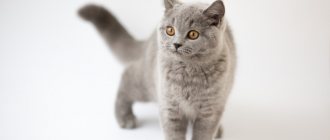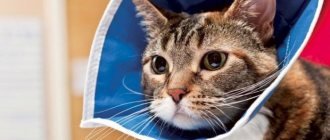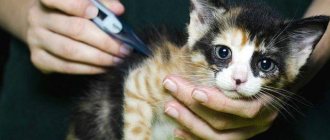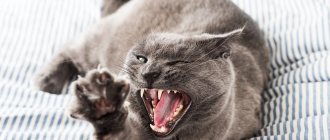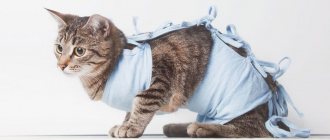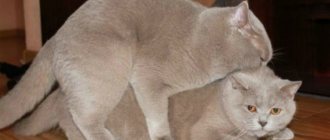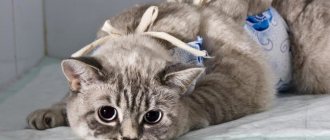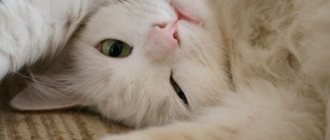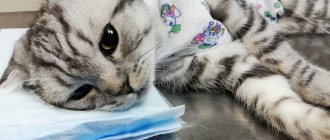If a cat pees after castration, this is a very serious and frightening problem. Minor embarrassments when an animal is under anesthesia or comes out of it can be considered the norm. If puddles appear wherever the pet lies or sleeps, this is urinary incontinence, which needs to be treated and controlled.
Castration procedure
Castration should be carried out on an empty stomach, due to the fact that general anesthesia is used. The pet is not fed 12 hours before surgery and is not given water for 6 hours. A kitten that is 7-10 months old is suitable for castration . If the cat is older than two years, additional examination is required before castration:
- blood tests;
- ECG;
- Ultrasound of the abdominal organs.
Two weeks before the operation, you need to get vaccinated and give the kitten an anthelmintic. After removal of the testicles, it is necessary to provide him with conditions for normal recovery.
How does anesthesia work on a cat?
Castration of cats (as well as males of other species) is considered the simplest and safest manipulation, unlike sterilization of cats - an abdominal operation that does not always end well.
There is no need to worry about how anesthesia will affect your animal or what complications there may be. Strong drugs are not used during castration. As a rule, in order for the procedure to be easy and painless, a light drug is sufficient to temporarily anesthetize the animal and put it to sleep without causing the slightest harm to its health.
The dosage of the drug is calculated based on the body weight and age of the four-legged patient. Veterinarians drew attention to a curious fact: animals with red fur require a larger dose of the drug than representatives of the cat breed of any other color, although the body weight of both may be the same.
It will take about 10-30 minutes for the cat to fall asleep after the administration of anesthesia. This does not depend on the quality of the drug used and, especially, not on the qualifications of the doctor. These are the individual characteristics of the body of each of our pets.
Some cats may feel nauseous after the injection, and sometimes vomiting occurs. This is a natural reaction of the body, often appearing in response to the administration of this type of drug. There is no need to worry about this, it’s just better not to feed the cat a few hours before the operation.
Recovery period
After a correctly performed procedure, the animal should recover within the first 24 hours. It is necessary to provide care, access to water and liquid food; when the cat recovers from anesthesia, he will begin to eat and drink on his own. After surgery, the animal should sleep as much as possible, then it will recover faster . Children and other pets should not be allowed near it. It is better if the kitten's sleeping place is on the floor on a special bed. Then the risk that he may fall from a height and be injured will be minimized. Some individuals may become so disoriented that they will begin to hide in inaccessible places and try to climb onto a cabinet. This should not be allowed; the kitten may fall or damage the seam.
If your pet refuses food and water after castration, the reason may lie in the nausea that he experiences, he needs to be given time.
Usually, even if a cat does not eat after castration, he drinks a lot of fluids, feeling thirsty after anesthesia. There are a number of symptoms that should alert pet owners if they persist two days after the procedure:
- manifestation of nausea, vomiting or urge;
- bowel dysfunction, constipation or diarrhea;
- constant desire to sleep;
- lack of appetite and reaction to external stimuli;
- disorders of the vestibular apparatus;
- fever and chills;
- redness or blanching of the mucous membranes.
After the removal of the gonads in a kitten, the hormonal background of the entire body changes completely, this takes time, and if the cat eats little after the operation, this may indicate a change in metabolism.
How and what to feed a cat after surgery?
The operation is performed under anesthesia. After waking up, the animal is desoldered from the syringe. It is better to offer food every other day, do not insist in case of refusal.
The preferred food on the first day is fermented milk products, porridge, boiled minced chicken. Subsequently, it is allowed to give low-fat meat broths, fruits and vegetables, boiled offal, and cereals. All ingredients are combined. It is especially important to ensure you drink plenty of fluids. The cat should have access to water around the clock.
Modern dry food manufacturers produce special food for sterilized cats . They contain all the necessary microelements and immunostimulants.
Modern dry food manufacturers produce special food for sterilized cats.
It is strictly forbidden to give during the postoperative period:
- fish;
- semolina, oatmeal;
- full-fat milk, sour cream, cream;
- fried food;
- smoked meats, sausages.
Raw meat is given in the form of minced meat. Veterinarians do not recommend mixing natural food, industrial feed, or overfeeding the animal. If your pet is fed home-cooked food, then mineral supplements and vitamins must be included in complementary foods.
Be sure to read:
How long to wear a blanket after sterilizing a cat, after how many days to remove it
Causes of lack of appetite
There may be several reasons why an animal refuses food or eats poorly after castration:
- pain after surgery forces the cat to refuse food, in this case he can be given painkillers prescribed by the veterinarian;
- nausea that occurs after anesthesia usually goes away within two days. When the cat does not eat for 3-4 days, you must contact the clinic;
- constipation due to intestinal dysfunction, which is provoked by anesthesia, may cause a lack of appetite in the animal. In this case, there will be additional symptoms: plaintive meowing, failure to go to the toilet, trembling of the cat’s backside;
- the animal’s poor health and lack of strength also explain why the cat does not eat after castration.
Usually, after complete recovery, the pet’s appetite returns and he continues his active life. It is not recommended to change the diet; you should give the usual food, only in a softer form. Normal appetite may not return immediately, and if a cat begins to eat little after castration, this does not mean that he is sick. The cause may be manifestations of emotional and hormonal changes.
The cat is shaking after sterilization: how to distinguish between normal and pathological (by day)
In most cases, a cat shakes after sterilization for quite “valid” reasons: its body seeks to warm up, for which it burns excess reserves (in the form of liver glycogen and subcutaneous fatty tissue). But still, in some situations, the animal must be shown to a veterinarian as quickly as possible, since otherwise serious postoperative complications may develop (including severe hypothermia). To do this, you need to know which behavior is normal for a cat, and which is a reason for an early visit to the veterinarian.
Changes in eating after surgery
After the operation, the animal’s body is rebuilt and at first the kitten may even lose weight, but if it begins to gain weight rapidly, its diet needs to be reconsidered.
After the pet is brought home after castration, it does not need a diet. In a couple of days the pet will come to its senses. If the cat starts eating, then everything is fine. There is no need to specially force him; it is better to leave the food overnight, because cats are nocturnal animals and at this time of day their appetite is better.
After castration, a cat may not eat well due to a change in its taste preferences. What he liked before the operation no longer causes his appetite and vice versa. You need to watch your pet and pay attention to what he chooses from food.
If your kitten is experiencing mental discomfort, you can tempt him with foods he loves. This will serve as a way out of post-operative depression. You can give fried chicken after removing the skin . This dish has a strong aroma and is not heavy on the stomach.
The animal's appetite usually improves by the time mobility is restored, but if the cat does not want to eat after castration surgery for several days, this indicates the development of some complications.
Mr. Cat recommends: what kind of cat will he become in the future?
You shouldn’t expect drastic changes: everything depends on the individual characteristics of the animal, its character and temperament. After castration, cats actually become calmer and more balanced, but in general their character remains the same. If the pet loved to play, run, and pester its owners, then even after castration it will lead an active life. He can only become lazier by growing older or older. But these are not the consequences of castration.
Many owners note that a cat, after undergoing castration surgery, begins to gain weight. This is due to the fact that the animal spends less energy due to hormonal changes. Therefore, the cat’s caloric intake after surgery must be slightly reduced.
You should not spoil your pet with treats often.
Many people feel guilty about neutering their cat and try to make amends by feeding the cat treats. This cannot be done, since excess weight and obesity cause many serious diseases. After castration, owners need to monitor the cat’s diet and feed it properly.
The animal does not require any special rehabilitation measures after castration. The owner must provide him with rest for several days after the intervention. When the wounds heal, the cat returns to normal: his habits and temperament do not change. With proper care, within 6-7 days after the operation he will forget about the stress he experienced.
What to do if the cat doesn't eat?
If more than three days have passed after the operation and the cat has not started eating, it should be fed with liquid broths from a pipette or syringe.
Lack of appetite three days after castration may signal the onset of a complication, but then there must be additional symptoms:
- increased body temperature of the animal;
- constipation or diarrhea;
- nausea and vomiting;
- non-healing suture;
- the appearance of bumps in the seam area;
- purulent or sanguineous discharge from the suture;
- does not react in any way to drinking or eating;
- the pet meows pitifully.
In this case, it is necessary to urgently take the cat to the veterinarian, there is a risk of developing peritonitis. If the suture is dry after castration, the cat feels good outwardly and is actively moving, it means that he is not yet accustomed to his new sensations. You can treat him to something tasty that he likes best.
You can give your cat vitamins, they will strengthen the body and improve appetite, but they must be prescribed by a veterinarian. A pet's meals should be divided, food should be given often and little by little, then there will be no problems with digestion. Low-fat cottage cheese and kefir contribute well to this. Gradually, the diet will improve, and the pet will again become playful and affectionate.
Castrates and urolithiasis
Unfortunately, castration has several negative consequences. They appear, however, not always and not for everyone. But the biggest danger facing sterilized animals is urolithiasis.
With this pathology, stones (uroliths) form in the kidneys, urinary ducts, bladder, etc. The disease is accompanied by attacks, during which the cat may die from painful shock. In addition, one of the classic signs of ICD is the “leaking” of the animal. Simply put, a pet with this pathology constantly strains, which is why urine is released in small portions anywhere (and there is often blood in it). Due to the persistence of this phenomenon, some breeders even get the impression that their pet is constantly marking its territory.
If you notice that your neutered pet (especially if he is elderly) is straining all the time and frequently visits the toilet (the litter often remains completely dry), then it’s time to sound the alarm. In cases where constant pushing is accompanied by a strong pain reaction, from which the cat literally howls and wheezes, he needs to be urgently taken to the veterinarian, regardless of the time of day or day of the week. A cat (especially an old one) can go to the best of all worlds “just” in pain at any moment, so don’t hesitate. In short, urinary incontinence after castration can be a dangerous sign.
A cat does not eat after castration: reasons for how to help your pet
Veterinarians and breeders quite rightly believe that castration is one of the easiest operations in veterinary medicine. It is often performed at home, and the need for general anesthesia does not arise in all cases. But this does not mean that sterilization does not involve any risk at all. Any procedure can always go wrong. Many owners, in particular, are interested in why the cat does not eat after castration. To be fair, it must be said that lack of appetite is not always a sign of some kind of pathology.
Possible complications after
Urinary incontinence after castration is one of the complications associated directly with surgery. Please note that castration is performed on both male and female cats. During the removal of the uterus and ovaries, the female has a negligible chance of damage to the urinary system, which results in urinary incontinence (temporary or chronic).
Castration of a cat is not an abdominal operation and even theoretically cannot lead to urinary incontinence. Of course, if a surgeon holds a scalpel for the first time, and his hands are shaking very much, medical errors are possible... but castration is a simple procedure that even a student veterinarian can perform.
general information
First, let's figure out what castration is. Many people believe that this is the name of exclusively a surgical operation performed to remove the sex glands (testes), but this is not entirely true.
Indeed, in our country, veterinarians prefer to use surgical sterilization, but in fact there are much more options:
- “Classical” surgical castration. Involves removal of the testes. Effective, inexpensive and fast operation.
- Chemical sterilization. In this case, drugs are injected directly into the testes, promoting atrophy of these organs and their “incapacity”.
- Medical castration. The veterinarian implants a cartridge “stuffed” with special medications under your pet’s skin. The latter, gradually released from the implant, suppress the sexual function of the animal.
- Radiation sterilization. The animal's testes are “treated” with a directed source of gamma radiation.
All three of the latter methods do not involve any serious surgical interventions, and therefore the procedures are very easy, complications develop extremely rarely and only in cases where the animal, for example, has a congenital intolerance to some drugs.
Remember! More than 90% of situations where an animal, after sterilization, refuses even the most attractive food occur precisely during surgical castration.
Treatment and what to do if a neutered cat starts peeing anywhere
The most popular and proven method here is to buy a large number of trays
. They are placed where the cat most often marks his territory and pees. The trays should be of different sizes, the sides should be of different heights, and the filling should be neutral and also different. If the cat does not sit in the tray. and walks nearby, then it’s worth changing the filler and trays. At one point, you will most likely notice how the pet scratches on the floor and meows. This is a signal that the pet wants to go to the toilet and litter tray, but does not understand how to go. In this case, it is enough to just be affectionate and put him in the tray yourself, while petting him and saying kind words.
This procedure should be done only after sterile treatment of all places where the pet has gone before.
. After all, for a cat, the toilet is where it has already gone, where there is smell and signs. It is necessary to wash without bleach or dangerous chemicals, because this can only harm the cat, who will still walk in familiar places for some time. However, over time, he will forget about them and get used to the trays placed around the territory. And after that, he will choose one tray for himself and go to it.
It is recommended not to move this tray anywhere and just let the cat choose the place where he wants to go.
.
If you couldn’t get rid of the smell and the cat is still marking for a month or more, you should clean it better and put something nearby that emits a light aroma. For example, citrus peels
. This is safe for the cat and will help fight off the smell.
Another option is to look at the barricades of those places that the cat has chosen. Cover the places with boxes and make the conditions as uncomfortable as possible. If the cat is neutered and has chosen the bed
, then you should use polyethylene and double tape, which will scare the pet and the cat will no longer return to this place.
In this matter, the main thing is patience and affection. You can't yell at your pet, you can't swear at him. Also, do not diagnose yourself. As we have already found out, there are many reasons and this is far from marking the territory. Also, castration is not the only reason. Therefore, it is recommended to call a veterinarian at home to examine and give a verdict. There is no point in taking your pet to the clinic in such a situation. This is extra stress for the pet, and the doctor simply will not see the places that the cat likes. He will not understand the behavior and is unlikely to make a correct diagnosis. The pet must be examined directly in the apartment.
Inflammatory processes
Unfortunately, this group of reasons is also quite common. Inflammatory processes in the operated scrotum have a serious impact on the animal’s well-being, which is why the cat does not show interest in even the most delicious food. The development of inflammatory processes is associated with gross violations of the rules of asepsis and antisepsis during surgery.
In addition, there are situations when a cat quickly comes to its senses after the procedure, starts playing, runs outside, and does other “indecent things.” All this can lead to contamination of the cavity of the scrotal sac and its bacterial contamination. This is dangerous not only due to the possibility of developing an inflammatory process, but also due to septic and necrotic processes. And this is a direct threat not only to the health, but even to the life of your pet.
How do you know if your cat has had a bad surgery and needs to be seen by a veterinarian as soon as possible? Take a closer look at your pet.
You should be concerned if you see the following signs:
- The pet feels unwell, breathes heavily, eats little or refuses food altogether, but at the same time drinks liters of water. This is how the cat’s body tries to cope with the consequences of intoxication.
- Look at the scrotum area: if an inflammatory process has developed there, the organ swells, turns red, and exudate oozes from the wound canal. If the case is advanced, the animal smells bad, the animal’s general body temperature rises, the cat is depressed and tries to spend more time huddled in the most remote corner.
- The genital area looks extremely untidy, the fur in this area looks like icicles. It sticks together, being saturated with exudative secretions.
If you notice these symptoms, you should immediately take your cat to the veterinarian. If an animal in this condition is not provided with timely medical assistance, it may well die from sepsis. In such cases, it is necessary to excise areas of dead tissue. The animal is prescribed loading doses of broad-spectrum antibiotics and other antimicrobial drugs. In some cases, the use of anti-inflammatory corticosteroids is recommended. They improve and accelerate the regeneration process.
Reasons why a cat trembles after sterilization
Any abdominal operation, including defertility of a cat, is not easily tolerated by the animal’s body.
The pet's body requires a lot of strength and energy to fully recover from its effects.
Blood loss
Blood loss is of particular importance. In total, the average pet’s body rarely contains more than 200-230 ml of blood. During a normal abdominal operation, a cat can lose up to 15-20 ml of “life-giving fluid”.
Taking into account its total volume in the body, such a loss cannot pass without a trace: the animal after the operation will not feel very well in any case. This is one of the causes of postoperative tremor (shaking). But in practice, the reasons for postoperative “shaking” are much more diverse.
Changes in thermoregulation
In particular, the body's systems do not operate in their usual mode after surgery. This especially applies to the body's thermoregulation system. She suffers from the same blood loss and enormous energy expenditure on the regeneration processes that are actively occurring in the animal’s body.
There is no longer enough strength to maintain a stable temperature of the internal organs and skin. The consequence of this is trembling: rapid and rhythmic muscle contractions are needed for the “idle” burning of ATP, accompanied by the release of heat.
Thus, in most cases, post-operative tremors are completely normal. The cat's body warms itself using its own “untouchable” energy reserves.
If a pet is operated on at the age of two or three years, and it has reserves of subcutaneous fatty tissue, then its body can heat itself for quite a long time, without problems arising. They appear if the animal is young and has not had time to accumulate such reserves.
If for some reason the regeneration process is delayed, the reserves are quickly depleted. The situation is aggravated by the fact that in this state the cat does not have a special appetite, and therefore her body has nowhere to take energy from. The combination of these factors can lead to severe hypothermia (hypothermia). If you do not follow the simplest rules of caring for an operated animal, it may simply freeze to death.
Side effects of anesthesia
There is another important reason for post-operative tremor. It's all about the "side effects" of the drugs used during anesthesia. All of them are poisonous to one degree or another, all have one or another side effect. Trembling is one of the most typical consequences of their use. This is especially true in the case of outdated drugs, which can have a whole “bouquet” of undesirable effects of use.
Inflammatory pathologies
Unfortunately, another common cause of severe shaking is much more dangerous. We are talking about postoperative inflammatory pathologies.
If during the operation the rules of asepsis and antisepsis were grossly violated, the risk of pathogenic or conditionally pathogenic microflora entering the body increases many times over.
The activity of microbes predictably leads to the development of inflammation, and as is known, it is often accompanied by fever of a constant or intermittent type. It is this that causes severe and often constant trembling. If your cat's body is hot to the touch, you should immediately contact your veterinarian: if you delay, the consequences will be too severe.
How to properly return a cat to normal life?
So, you took your pet to the veterinarian and found out why the animal's appetite has decreased. Let's assume that as a result of timely medical care, the cat began to become interested in food again. But what to do next?
Important! Belly feeding an animal that has not eaten anything for a long time is a very bad idea. At best, this is fraught with digestive disorders, at worst, intestinal obstruction and death.
In a word, you should stop the “diet” gradually. First, you need to give your cat small amounts of chicken broth (low-fat). After a few hours, you can add a little boiled chicken or lean offal to this dish. If everything is normal and your cat’s digestive system gradually adapts to its normal operating mode, then after about a week you can feed your pet as usual.
But! Please note that the nutrition of castrated cats has its own nuances. Firstly, the calorie content of the daily diet should be reduced by about one and a half times. Secondly, if the pet was spayed at the age of more than four years, it is necessary to limit the amount of protein. Thirdly, we strongly advise you to completely exclude fish from the animal’s diet.
Is there life after anesthesia?
Until recently, most surgical castrations were performed only under local anesthesia, or even without it at all. But today, veterinarians are increasingly resorting to the use of general anesthesia. The older the animal, the greater the potential risk of general anesthesia; the likelihood of developing side effects is quite high.
In particular, many pets recover from anesthesia for a long time, having difficulty returning to a normal state. For some animals this can take up to two days. Throughout this period, they feel extremely unwell, their coordination of movements is impaired, their memory and reflexes fail...
Important! Do not scold your cat if, after anesthesia, he makes a puddle right next to the bowl or pees on his bed.
There is nothing wrong with this; subsequently the animal’s body will recover from “hibernation” and everything will return to normal.
It also doesn't hurt to keep an eye on your cat. Very often, after waking up from medicated sleep, our pets experience incredible thirst . It can be so strong that some cats managed to unscrew the taps in the sink just to drink more. Simply put, the pet drinks constantly. And this, for obvious reasons, stimulates intense urine production, which is why the animal can pee all the time.
General information about castration
Castration is a technically simple operation to remove the testes (testicles) of a male. In veterinary medicine, castration is recognized as the most common procedure. Despite the low morbidity, simplicity of the procedure and rehabilitation, castration is carried out under general anesthesia, which implies a number of risks.
Before surgery, your pet must be shown to a doctor. Depending on the results of the examination, procedures may be prescribed:
- Prevention of worms, fleas - infestation by any parasites constantly weakens the animal’s body. If a cat has worms, in addition to reduced immunity, their waste products poison the body and cause the liver to work harder. It is necessary to rid the patient of worms at least 2 weeks before the operation so that the liver has time to enter a normal rhythm of work and prepare for increased load.
- Diet for weight loss - obesity, this increases the load on the heart, which is an unacceptable risk when using anesthesia.
- Diet for weight gain - the reaction of a cat’s body to anesthesia, suffering from exhaustion and dehydration, cannot be predicted.
- General and biochemical blood test - special attention is paid to the level of hemoglobin, leukocytes and liver tests. A low hemoglobin level indicates anemia, which is a contraindication to anesthesia. A high level of white blood cells indicates an infection or virus that is already attacking the body, which means that surgery cannot be performed. Liver tests, bilirubin and others, reflect the condition of the liver - the organ on which the animal’s recovery from anesthesia will depend.
- Urinalysis - carried out to detect protein or minerals. A large amount of white indicates kidney inflammation. The accumulation of salts indicates urolithiasis. In both cases, the cat needs to be cured and only then neutered.
- Swabs to detect sexually transmitted infections.
- If kidney problems are suspected, an ultrasound examination is performed.
- If the heartbeat or breathing rhythms are disturbed, consult a specialist (cardiologist), ultrasound of the heart.
How does the character of castrated cats change?
Almost all cat owners whose pets have undergone removal of the testes note how much the character of their pets has improved. Of course, if the cat was affectionate and gentle before the operation, he will remain so after it. But aggressive specimens, on the contrary, become much calmer, balanced and flexible. If previously communication with the owner was limited only to bites and scratches, then after castration such a cat can be petted almost without fear.
Castration does not affect the character of a young animal operated on at an early age. The cat will remain as playful and cheerful as it was before the operation, and, what is especially pleasant, will retain this character trait until old age. All that is required from the owners is to take part in his endless games and pranks or get him a companion - not necessarily a cat!
The situation is different with animals that were castrated at a fairly mature age, whose character has had time to fully develop. After castration, they become too phlegmatic for active games, preferring to spend time in a blissful slumber, basking in the sun or curling up in a secluded corner. Such cats, whose body does not receive enough physical activity, may develop problems with the heart and joints, especially if they are overweight. This especially often affects cats of the British breed, whose phlegmatic nature has become the talk of the town. To maintain the health of your pet, try at every opportunity to stir him up and involve him in a fun game. And when the weather permits, put a harness on him and go for a walk. It will benefit both him and you!
Effect of anesthesia
Although castration is considered a simple procedure, it is performed under general anesthesia. The drug literally turns off areas of the brain that are responsible for muscle tension and relaxation, pain and wakefulness. A cat under anesthesia doesn’t just sleep, it switches off, doesn’t hear or see anything. Usually, to maintain the animal’s body, drugs that stabilize blood pressure and support the heart are used. Along with anesthesia, local and general anesthesia is required.
The liver is responsible for removing all these drugs from the body, which is under heavy load for at least another day after the operation. To accurately calculate the dosage, the veterinarian weighs the cat. Usually the dose of the drug is calculated so that the cat sleeps for 10–15 minutes; the operation takes longer only in case of complications. For example, a veterinarian may discover a cyst or tumor after cutting the scrotum. Any neoplasm is equipped with blood vessels, so its removal is carried out very carefully.
The dose of anesthesia may also increase due to stress . It often happens that a cat that was brought to a veterinary clinic not only does not fall asleep, but begins to rage after the first dose is administered. Here the owner is faced with a choice: allow the veterinarian to add a dose of anesthesia or take the pet home. If your cat has never been outside, at-home neutering may be an alternative.
The first hours after surgery and care features
With the correct dosage calculation, the cat begins to wake up and raise its head immediately after the end of the operation. Stay in the clinic until the pet tries to stand on its paws. The cat begins to feel a loss of balance the moment the medications that control blood pressure stop working.
If you have surgery in a clinic, you will need a carrier and a heating pad . After anesthesia, the cat will not be able to control its body temperature; it can drop to a critically low level even on a warm day. Do not open the carrier unless necessary; when coming out of anesthesia, your pet may hallucinate and behave in the most unpredictable ways.
Note that many cats after castration do not try to get up and be active. The pet can simply open its eyes, look around and fall asleep again. This behavior is much safer, but there are some nuances.
Important! If the cat sleeps for too long, you need to make sure that his eyes are closed (otherwise they will dry out). The second important point is oral irrigation. The pet is too weak to stand or walk, but will be thirsty.
If a cat doesn’t eat well after castration or refuses food on the first day, this is normal. If your pet flatly refuses water, this is a very alarming sign. Place a few drops of warm water into the cat's mouth as soon as you see him moving his ears or blinking (not sleeping). Too much water can cause nausea and vomiting, and cramps after surgery can cause headaches and even greater weakness.
Note! Showing absolute indifference to food, the cat can show enviable activity, walking, running and even jumping. Until your pet comes to his senses, keep all windows closed. It is best to allocate a separate room for the cat and close it every time he is left unattended.
Prepare a comfortable, soft bed for your cat, protected from drafts. After surgery, it is convenient to use a carrier with a removable lid. When the shelter is closed, the cat feels calm.
Cats are recommended to wear a postoperative collar to prevent the postoperative suture from licking. The collar must be selected according to size. It is advisable to choose an accessory made of soft material so that the cat can sleep in it. Keep your eyes on your pet if you decide to temporarily remove the collar. Believe me, a few seconds will be enough for a cat to chew out the drainage or chew through the knots of the suture material.
Rules for feeding a cat in the sterilization field by day
The veterinarians at the clinic will learn about feeding rules. This is especially true for the consistency and quantity of food, because food can put pressure on the walls of the abdominal cavity, the site of the operation.
Anesthesia slows down intestinal motility, which prevents the passage of undigested food. As a result, food ferments and rots, the cat suffers from gas formation, bloating, and poisoning.
Therefore, veterinarians recommend giving the animal its first food the day after surgery and ensuring it drinks plenty of fluids to avoid dehydration. Otherwise, the blood thickens, it stagnates in the chambers of the heart, and the blood supply slows down.
Sometimes this condition leads to death, the heart stops.
| Day | What to feed |
| First | The cat is given a lot to drink and is not insisted on feeding |
| Second | Give a portion of food not exceeding 1/3 of the standard portion. You should not give heavy food, since the animal cannot push after surgery. All products must be fresh so as not to harm a weakened body |
| Third | As a rule, on the 3rd day the pet itself asks for food. The portion is gradually increased, but should not exceed 130 g, since sterilized cats are prone to obesity The pet can fast even on the 3rd day, but at the same time she feels good: she is mobile and behaves as usual. In this case, owners do not need to worry. You can offer your pet another food or add a few drops of fish oil for appetite. It is necessary to monitor whether the cat went to the toilet or not. In some cases, she refuses to eat due to constipation. You need to lightly feel the stomach: if there is a lump, you can do an enema or give a laxative |
If your pet does not touch food on the 4th day, you should immediately contact a specialist. There are cases when an animal immediately after sterilization begins to eat normally, but on the 4-5th day it stops eating.
In such a situation, you need to measure body temperature, examine the mucous membranes, and look at the color of the suture. If the mucous membranes are pale and bluish, and the suture is red and purulent, the cat should be shown to a veterinarian.
We suggest you read: A cat has snot and a bleeding nose when he sneezes: what to do, the reasons why a cat sneezes with blood, how to stop a cat’s nose from bleeding when sneezing
It is necessary to start feeding the cat only 12 hours after surgery, since during this time the animal’s gastrointestinal tract does not work well, and it may vomit after eating.
When compiling further menus, it is imperative to take into account how the animal ate before sterilization. The most acceptable are cat foods, since they contain balanced components necessary for a pet.
Food for a sterilized cat
- First day. A cat does not eat well after sterilization for 24 hours; this is normal. This is the period when the animal is completely exhausted and cannot show interest in food or water. You can give your cat water a few hours after the operation, but before that you can only moisten a little sponge or drop a couple of drops of water on the tongue to avoid dehydration.
- Second day. If there are no complications, the animal may begin to show interest in food, and it is worth feeding it with special cat food. You should choose those whose action is aimed at restoring the body after operations or illnesses. It is worth opting for canned food such as Royal Canin, Hill's, Purina, etc. But if before the operation the animal was home-fed, then it should be boiled chicken broth and add a little twisted meat.
- The third day. The cat should begin to eat on its own without any help. But if this is not observed, you should pay attention to the pet’s behavior. If she meows, there is an unpleasant odor coming from the stitches, or the wound is bleeding, then the animal should be immediately shown to a doctor.
- Fourth day. If the cat still does not eat anything, then this most likely means the presence of complications such as peritonitis, sepsis or problems with the gastrointestinal tract. If the cat ate normally for the first four days, and then suddenly began to refuse to eat, this may mean the occurrence of delayed intestinal atony or problems with the liver or kidneys. The fourth day without food after surgery may mean that the cat is dying, so you need to drop everything and run with it to the veterinary clinic.
- Fifth day. You can already start giving everything that the animal ate before surgery. But if during the first five days the cat took food reluctantly, and sometimes even refused it altogether, then it can lose a lot of weight, and in this case it is necessary to introduce high-quality food into the diet and take additional medications that are prescribed only by a veterinarian.
Many animals recover easily and quickly after surgery.
If the cat does not drink after sterilization or does not eat anything after two days, then you should seek help from a veterinarian, who will identify the complication in time and give further recommendations for treatment.
Effect of surgery on appetite and possible complications
What to do if 2 days have passed after castration and the cat does not touch food? First, let's define what should be considered food. After surgery, your pet is not recommended to eat solid food, so he receives liquid foods. The cat physically drinks, but actually eats, since everything that is not water is food.
For convenience, let's call all liquid foods nutrient solutions. After surgery, it is advisable for the cat’s diet to consist of:
- Natural fermented milk products. It is better to abstain from milk, as there is a high risk of developing diarrhea.
- Low-fat broths from meat and fish.
- Boiled meat, minced until smooth, diluted with broth.
- Warm, sweet tea (2 tablespoons of sugar per 250 ml of liquid).
So, for 2-3 days and even a week, the cat can absorb only nutrient solutions. Moreover, if the pet is prescribed maintenance therapy (vitamins, minerals, buffer solutions), the cat’s appetite will be noticeably suppressed. You need to understand what cats eat to survive. Of course, the pet feels hungry, but after eating the broth (or other light product), this feeling goes away. Maintenance therapy saturates the body, which gives the cat the opportunity to sleep more and not worry about hunger.
Immediately after surgery, for 2–3 months, the cat may eat worse if there were complications during the procedure. Some stimulant drugs affect metabolism, which can lead to both worsening and increased appetite. If your cat eats little, suffers from diarrhea, and looks weak, dysbacteriosis may be the cause. The fact is that after the operation the cat is prescribed broad-spectrum antibiotics, but they do not distinguish between good and bad bacteria, they destroy them all.
If the intestinal microflora was weakened before castration, drug therapy will only worsen its condition. As a result, the food will not be digested, it will ferment, and the cat will suffer from bloating, abdominal pain and gas. If your cat begins to eat poorly even without a veterinarian’s prescription, you can give him medications with lactobacilli and monitor his condition. Usually within a few days the condition improves noticeably.
For several days after the operation, the cat’s body will be weakened; if the pet suffered from a sluggish illness before castration, it may worsen. Carefully monitor the condition of your ward; if he drinks, sleeps a lot and behaves relatively calmly, this is normal.
Important! Be sure to carry out pain relief therapy when the cat is in pain and will not even eat his favorite treats.
The cat continues to mark its territory: possible causes and solutions
Some owners of domestic cats note that the cat continues to leave marks even after the testes are removed. There may be several reasons for this. Some animals have a pathology such as cryptorchidism (undescended testicle into the scrotum). An inexperienced veterinarian may not be able to find the seminal duct of an undescended testicle; as a result, the testis remains in the abdominal cavity and continues to function as usual, producing sex hormones.
Also, a cat can continue to mark if it was neutered as an adult. Veterinarians consider the optimal period for the operation to be from 8 months to a year. If an animal is castrated at two years of age or older, the habit of leaving marks may continue even after the testes are removed. However, changes in hormonal levels affect the smell of urine. In sexually active cats it has a sharp, pronounced odor. After castration, urine stops smelling strongly.
If there are several cats living in the house, and only one of them has been neutered, then he can mark the territory, focusing on the behavior of his brothers.
It is quite difficult to wean a cat from marking. If the reason is a testicle that was not removed due to cryptorchidism, then a repeat operation will have to be performed to remove the organ that continues to function from the abdominal cavity.
You can purchase special aerosols in a specialized store. By spraying them on areas where your cat usually marks, you can discourage him from this habit. In rare cases, an animal may require the help of a specialist such as an animal psychologist.
You should contact him if, after castration, the cat’s behavior has changed for the worse: he has become overly aggressive, does not want to contact his owners and other animals, continues to mark his territory, yell and ask to go outside.
Such cases are extremely rare. The psychologist will try to determine the reasons for this behavior and give recommendations to the owners.
A cat does not eat after castration: causes of starvation and healthy nutrition
After the death of his owner, the cat Ryzhik hid in the apartment, they didn’t find him, they decided that he had run away, and a month later, when they opened the apartment due to an invasion of cockroaches, they found a barely alive cat lying in the middle of the room. They pulled him out and left him on the stairs. .. It was taken by a girl from the Peak. Trying to get out.
Blood tests were done, treatment was prescribed, the cat was taken for injections and drips. But he doesn’t eat at all, he pees well after IVs, he drinks. He mewls as if something is bothering him. And he tilts his head to the side...
What does a cat look like after surgery?
Many owners of pet cats, especially those unprepared for such a spectacle, are horrified by the sight of their pets having just undergone surgery. No surprise! A cat often lying motionless, with eyes wide open, breathing intermittently is not a sight for the faint of heart. And if his paws also twitch slightly in convulsions, then the owner may even be frightened and decide that he is losing his pet.
Do not worry! This reaction of the body is considered completely normal, any veterinarian will confirm this to you.
